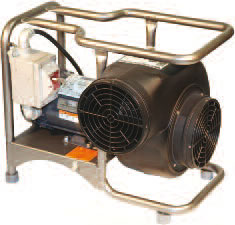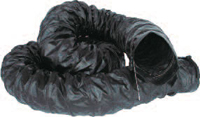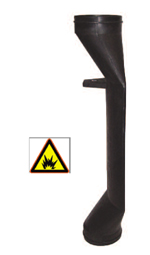Ventilation Equipment Selection for Hazardous Locations |
||
|---|---|---|
Once it is determined there is a hazardous location or potential for a hazardous work location, it is ne-cessary to take every precaution to guard against ignition of the hazardous atmosphere. The traditional “CombustionTriangle” is made up of three elements: 1) fuel, 2) oxygen and 3) an ignition source. All three must be considered when developing a plan to ventilate hazardous or potentially hazardous environ-ments. Hazardous location electrical equipment, approved by a Nationally Recognized Testing Laboratory (NRTL) such as UL or CSA, is designed and constructed to eliminate the potential for ignition of the work environment. The following is a list of equipment criteria to consider for all hazardous locations: |
||
| Explosion-Proof Electric Products - Units should have a hazard labelstating Class, Group, and Division approvals listed from the approving agency, e.g. CSA or UL. Blowers should have a grounding lug to ground the unit and safely remove the build-up of static electricity to a safe grounded source. These types of electric blowers should have a metal frame and housing or a conductive-plastic housing to assure a good ground to the electrical source and an aluminum non-sparking blower wheel to prevent metal sparking. Intrinsically Safe Equipment - Electrical equipment should be certified as intrinsically safe due to its low voltage properties. Pneumatic or airdriven equip-ment cannot cause a spark and do not require third party electrical approval because there are no electrical parts. Even with intrinsically safeequipment, proper grounding and non-sparking components should still beutilized at all times. |
 |
|
| Conductive Ducting- Choose ventilation duct that has fabric made of conductive material. This type of duct will reduce the potential build-up of static electricity on both the interior and exterior surfaces of the duct that can result from the movement of air and small dust particles during ventilation. Air Systems adds a grounding wire to the conductive duct’s interior wire helix; it attaches to the blower so that any static charges can be removed to either the blower’s ground lug or to Air Systems’ Conductive Saddle Vent® Ventilation System. |
 |
|
| Controlling Static Electricity in Hazardous Ventilation Locations The Saddle Vent® was developed and patented by Air Systems International over 25 years ago as a safety tool to maintain continuous ventilation while allowing unrestricted entry and egress to a manhole or tank. Air Systems has continued to improve the Saddle Vent® by developing a fully conductive Saddle Vent® and a ventilation method for removing static electricity from the entire ventilation system. This system consists of the entire length of ventilation duct all the way back to the blower and safely discharging static to a safe electrical ground. The new recommended method, The Conductive Saddle Vent® Ventilation System, uses conductive ventilation ducting connected to the Conductive Saddle Vent® which is then connected to an explosion-proof or pneumatic blower. The entire system is assembled above ground in less than five minutes before installing it in the opening to the manhole or tank; it can then be tested for electrical conductivity using a standard ohm meter. |
 |
|
| Achieving an electrical resistance reading less than 500K ohms will assure an electrical path is made for static electricity to safely discharge back to the blower and its grounded electrical connection. This ventilation system is the only safety industry method for safely removing static build-up during confined space entry; it provides continuous confined space ventilation, unrestricted entry and egress and the entire system can be tested prior to commencing work operations in a hazardous work area. Controlling static electricity discharge will prevent spontaneous ignition of hazardous vapors and dusts. As a work tool, The Conductive Saddle Vent® Ventilation System will allow workers to concentrate on the many other hazards associated with working in a confined space while maintaining continuous ventilation. | ||